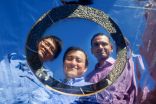The skin cells formed normal human skin when grafted onto the backs of laboratory mice, they said.
The findings represent a major advance in the battle against the disease, epidermolysis bullosa, in which the top layer of skin, called the epidermis, sloughs off with the slightest friction, leaving open wounds that are difficult to heal. Severely stricken children who survive into their late teens or early 20s often die from invasive squamous cell carcinoma, a skin cancer that can arise during repeated cycles of skin wounding and healing.
"Epidermolysis bullosa is a truly horrible, debilitating skin disease in which the top layer of skin is not properly anchored to the underlying layers," said Anthony Oro, MD, PhD, professor of dermatology. "When they are born, the trauma of birth rips away their skin, and they continue to suffer severe skin wounds that require constant bandaging and medical attention throughout their lives."
Stanford has one of the largest epidermolysis bullosa clinics in the world, with an extremely active and engaged population of patients and their families eager to help researchers. The Stanford Department of Dermatology has been working to find new treatments for the disease for over 20 years. The latest advance, in which researchers replaced the mutated, disease-causing gene in the donor-made induced pluripotent stem cells with a healthy version, was funded by an $11.7 million grant from the California Institute for Regenerative Medicine.
New avenue of treatment
"This treatment approach represents an entirely new paradigm for this disease," Oro said. "Normally, treatment has been confined to surgical approaches to repair damaged skin, or medical approaches to prevent and repair damage. But by replacing the faulty gene with a correct version in stem cells, and then converting those corrected stem cells to keratinocytes, we have the possibility of achieving a permanent fix -- replacing damaged areas with healthy, perfectly matched skin grafts."
Oro is one of the two senior authors of a paper, which will be published Nov. 26 in Science Translational Medicine, describing the research. Vittorio Sebastiano, PhD, an assistant professor of obstetrics and gynecology, and research associate Hanson Zhen share lead authorship.
The Stanford paper will be one of three in that journal issue to focus on gene therapy approaches for epidermolysis bullosa, also known as EB. All three studies use similar approaches, but each are in some ways unique. Unlike the other studies, the Stanford approach uses induced pluripotent stem cells, or iPS cells, from human patients and directly replaces the faulty gene with new copy.
The Stanford researchers are particularly hopeful that they can begin experiments in humans relatively quickly. At CIRM's insistence, they've been working hand in hand with the U.S. Food and Drug Administration to ensure that the steps they've taken in the mouse studies mirror as closely as possible those that would be required to create modified cells for use in humans. For example, they've hewn closely to a concept known as good manufacturing practices, required by the FDA to ensure that pharmaceuticals and biologic materials are produced in a way that makes them safe for human use.
Translating the results from mice to humans
"CIRM made sure that we were always keeping in mind the need to translate our results to the clinic," said Marius Wernig, MD, associate professor of pathology and the other senior author of the paper. "Now we've shown that this approach that we call 'therapeutic reprogramming' works well with human cells. We can indeed take skin cells from people with epidermolysis bullosa, convert them to iPS cells, replace the faulty collagen 7 gene with a new copy, and then finally convert these cells to keratinocytes to generate human skin. It is almost like a fountain of youth that, in principle, produces an endless supply of new, healthy skin from a patient's own cells."
Encouraged by the efficacy in mice, the researchers believe that the viability of the manufactured skin could be extended during human trials.
Epidermolysis bullosa can be caused by mutations in at least 18 genes. The type the researchers were studying, autosomal recessive dystrophic epidermolysis bullosa, is caused by mutations in the gene that encodes for type-7 collagen. This collagen serves to anchor the top layer of the epidermis to the underlying dermal layers.
Skin has many advantages for researchers studying approaches to gene therapy. It's easily accessible, and clinicians have had decades of experience applying skin grafts to burn victims. It's easy to visually monitor the health of the grafted skin, and it's also fairly simple to remove a failed graft.
To conduct the study, researchers in Wernig's laboratory used a new technique to create iPS cells from EB patients' skin cells. They then consulted with Mark Kay, MD, PhD, a professor of genetics at Stanford who has decades of experience using a virus called an adeno-associated virus to insert genes into cells. Kay, who is also the Dennis Farrey Family Professor of Pediatrics and a co-author of the study, has focused mostly on trying to correct certain types of hemophilia, a bleeding disorder. Recently, he and his laboratory hit on a way to target and then replace the faulty clotting factor gene with a corrected copy.
The technique -- which Kay, Oro and colleagues described in a paper published in January in Molecular Therapy and in a follow-up paper in October in Nature -- capitalizes on a biological phenomenon called homologous recombination to insert the gene into a cell's genome at a particular location, rather than relying on an unintegrated gene, the expression of which can wane over time, or random integration into the DNA, which can cause cancers and other problems.
Fixing the faulty gene
"This is the best possible way to fix the faulty collagen gene," Wernig said. "Unlike other gene therapy approaches, homologous recombination targets the native location of the gene and results in a permanent fix without the risk to induce random mutations that could cause cancer."
Finally, the researchers took one additional step. Because a subpopulation of the skin cells initially obtained from the patients are likely to already carry some skin-cancer-causing mutations, they looked closely at the genomes of the resulting iPS cells.
"We took the corrected stem cells and screened them for the presence of mutations known to be associated with the development of invasive squamous cell carcinoma," Oro said. "By removing those clones before making the new keratinocytes, we have the best possible chance of providing the healthy skin the patients so desperately need."
In the next step, Oro and his colleagues painstakingly developed and optimized the keratinocyte differentiation protocol for use in humans using FDA-mandated guidelines. They also confirmed the cells were secreting functional collagen 7. Once they had sheets of fully developed skin in laboratory dishes, they grafted them onto the backs of mice with compromised immune systems (animals with intact immune systems would quickly reject the human cells). Remarkably, these iPS cell-derived sheets formed human skin very similar to sheets made from ordinary human skin keratinocytes.
"The most difficult part of this procedure is to show not just that you can make keratinocytes from the corrected stem cells, but that you can then use them to make graftable skin," Oro said. "What we'd love to do is to be able to give patients healthy skin grafts on the areas that they bang a lot, such as hands and feet and elbows -- those places that don't heal well. That alone would significantly improve our patients' lives. We don't know how long these grafts might last in humans; we may need some improvements. But I think we're getting very close."
Oro and Wernig emphasized the collaborative nature of the research with the very patients they are trying to help.
"These patients are amazing," Oro said. "They are very active partners in this research, and we in the EB medical community would do anything to help them."
INFORMATION:
Other Stanford co-authors are Alfred Lane, MD, emeritus professor of dermatology and of pediatrics; postdoctoral scholars Sandra Melo, PhD, Jiang Li, PhD, Susie Lee, PhD, Lingjie Li, PhD, Leszek Lisowski, PhD, and Pei Wang, PhD; senior research scientist Zurab Siprashvili, PhD; instructor Thomas Leung, MD, PhD; program manager Andrea Tichy, PhD; bioinformatician Jiang Li; research assistant Elizaveta Bashirova; graduate student Bahareh Haddad Derafshi; and undergraduate student John Hawkins.
Lane is the principal investigator on the CIRM grant; Oro and Wernig are the co-principal investigators. Oro and Wernig are both members of the Stanford Cancer Institute.
The study was funded by CIRM, the Children's Health Research Institute, the Howard Hughes Medical Institute, the New York Stem Cell Foundation-Robertson Investigator Program and the National Institutes of Health (grant ARO55914).
Information about Stanford's dermatology and pathology departments, which also supported the work, is available at http://dermatology.stanford.edu/ and http://pathology.stanford.edu.
The Stanford University School of Medicine consistently ranks among the nation's top medical schools, integrating research, medical education, patient care and community service. For more news about the school, please visit http://med.stanford.edu/school.html. The medical school is part of Stanford Medicine, which includes Stanford Health Care and Lucile Packard Children's Hospital Stanford. For information about all three, please visit http://med.stanford.edu.
Print media contact: Krista Conger at (650) 725-5371 (kristac@stanford.edu)
Broadcast media contact: Margarita Gallardo at (650) 723-7897 (mjgallardo@stanford.edu)





